Being black can mean watching every move you make. I’ve had black friends tell me they’ll never eat fried chicken in front of white people because they’re scared of fulfilling a “stereotype.” Watermelon and sunflower seeds are other no-go foods for some. So Theresa Chromati’s painting of a black woman munching on sunflower seeds and spitting the shells into a hand is a “YAS”-inducing piece of work. Through her dark-skinned characters and use of patterned fabrics and glitter, the New York-based painter imagines a world in which black women are able to just exist. Her full-lipped, curvaceous characters wrestle in the nude, strut down streets like they own them, and live gloriously hedonistic lives. And Theresa’s surrealist and subversive world has gained the art world’s attention. Last year, she staged her solo exhibition, Strange Noise on the Rooftop, at LA’s New Art Gallery, and this year she has shows coming up in New York and Baltimore.
“The work is kind of like a mirror to my life,” Theresa says, explaining her brightly colored world of masks and strong female bonds. “As a black woman, there’s a lot of putting on armor — both with others and yourself. The masks in my paintings are an armor. They keep you safe and show who you are, but also protect the goods within yourself.”

The colors and characters of Theresa’s alternative universe first came to her during college. She looked to art-deco paintings for inspiration, intrigued by how the subjects were always drawn from the side. “The lines eventually keep growing softer and softer,” she says. And as her empowering, stereotype-confronting world has grown more complex, her characters have left the canvas. Theresa sells a collection of dresses and wraps with her characters printed on them, using fabrics that evoke Western African textiles. And she wants to continue exploring her leisure-filled world in unconventional ways. She’s hoping to incorporate taste, in addition to sight and sound, into her next Baltimore exhibition (the details are still secret) and is creating a piece of animation that will feature her thicker characters soon.
Theresa talks to i-D about reclaiming the term “BBW” (big beautiful women) and creating a surrealist world of unapologetic black femininity.

Your paintings feature recurring characters that exist in a specific world, making them feel like graphic novels sometimes. How did you develop these characters? They seem to play on offensive caricatures and dismiss them at the same time.
My second year of college is definitely when my style came together. I was put on to a lot of realism and I was really bored with that. I went to college in a small Delaware town before going to Pratt — so I had nothing to do. I spent a lot of my time just trying to come up with my style. I was really obsessed with art-deco. So all those figures I was drawing had really hard lines, but they were all shown from one side. Things just kept evolving from there and the lines got softer.

You often pair your paintings with soundscapes, and you almost studied classical music. How do you use music to explore your character’s feelings?
It’s more a part of the viewing process than the painting process. Having a classical background has a large influence on how I want the pieces to live. While you’re looking at them, I want you to explore what it sounds like in this world. What do their emotions sound like? So I work with a producer, my friend Pangelica, and I send her random sounds like footsteps and she sifts through them and builds off the story I’m telling with the painting.

Curvy black women occupy a unique place in pop culture. Curves are idolized in rap, “BBW” has become a popular search term in porn , and, historically, the black female shape is exocitized by white culture. What about “BBW” are you trying to reclaim?
Pretty much all my shows build off the same topic. In my show BBW two years ago, I wanted to reclaim the term and have it better represent the diversity of black women. For example, there was a painting in that show of two women called Between Braiding and Weaving. Just something simple like that. I wanted to capture moments that are shared between women that I think are really beautiful.

How have other black women responded to your work?
I’ve gotten a lot of really emotional and positive responses from women I haven’t met before. I’m trying to change the lack of representation when it comes to the diversity of black women. I want the beauty of black women to be shown. And I don’t just mean physical beauty. I feel like we’re always in the background or holding other people up — like men and white women. You don’t get to see enough representations of joy. So if you pay attention to anything in my work, I hope it’s the partnership and community among black women I’m showing. I want to illustrate how we talk to each other and balance each other’s lives.

You’ve managed to have a successful career as a young artist, receiving fellowships and creating freelance illustrations for VICE. Can you tell me about moving into clothing?
The clothing thing just kind of happened! I won a fellowship where they produce the clothing for you. All you have to do is design what you want. I really wanted to create something that, like the rest of my work, was really out there and loud about the beauty and importance of black women. So it really was a different kind of artistic exploration of this world.

